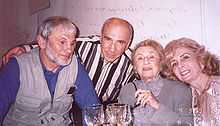Bel Kaufman
| Bel Kaufman | |
|---|---|
 Gennadiy Prashkevich (left) and Bel Kaufman (second from right) | |
| Born |
May 10, 1911 Berlin, Germany |
| Ethnicity | Jewish[1] |
| Education | Columbia University (MA) |
| Alma mater | Hunter College (1934) |
| Occupation | Writer, instructor |
| Known for | Up the Down Staircase (novel) |
Bella "Bel" Kaufman (born May 10, 1911) is an American teacher and author, best known for writing the 1965 bestselling novel Up the Down Staircase.
Early life
Kaufman was born in Berlin, Germany, where her father was studying medicine.[2] Although she was born in Germany, her native language was Russian. She was raised in Odessa and Kiev (present-day Republic of Ukraine). As a child, she published her first poem, "Spring", in an Odessa magazine. Life was difficult."Dead bodies were frozen in peculiar positions on the street," she recalled. "People ate bread made of the shells of peas because there was no flour."—Bel Kaufman[1]
She emigrated to the United States in 1923 at age 12 with her parents. They lived in New York City, where she first began learning English. Aged 18 she attended Hunter College in New York, from which she received a Bachelor of Arts degree, then earned a Master's degree in literature at Columbia University.[1][3]
Career
Kaufman began work as a teacher in various New York City high schools, while also working part-time as a writer (including articles for Esquire magazine) under the name Bel Kaufman.
In 1965 she published the novel Up the Down Staircase, a novel about an idealistic young honors college graduate who becomes an English teacher in a New York City high school and deals with the gritty realities of her colleagues and students; it was based on Kaufman's own teaching experiences. Up the Down Staircase became an enormous success, remaining on the New York Times Best Seller list for 64 weeks.[1] In 1967, the book was turned into a film of the same name.
In 1979 Kaufman published a second novel, Love, etc.. She has, since then, written various short stories. She has also continued as a teacher and lecturer in New York City. According to Pearson Education, Kaufman has written, "I do not LIKE writing; in truth, I HATE writing, and would rather do anything else. But the joy comes when, almost in spite of myself, I come close to what I want to say. A sentence or an insight leaps from the page."[4]
In February 2011, Bel Kaufman, at age 99, became the oldest known hired professor when she was hired by her alma mater Hunter College. Kaufman, teaching coursework on Jewish humor, turned 100 years old during her first semester of instruction. "I'm too busy to get old", noted Kaufman, who still spends her days writing in her booklined study on the Upper East Side of Manhattan.[5]
Personal life
Kaufman married Sydney Goldstine in 1940; they had two children: Jonathan (a retired computer science professor) and Thea (a psychologist).[1] The couple divorced in the 1960s. Sydney Goldstine died in 2000.
Kaufman is the granddaughter of famed Yiddish writer Sholem Aleichem.[1][5] In 2010, she celebrated her 99th birthday at the annual memorial to her grandfather. She married a second time, to Sidney J. Gluck, who runs the Sholem Aleichem Memorial Foundation.[1] She was still alive and writing at age 101, in July 2012.[6]
Awards and honors
- Honorary chairman of the Yiddish Studies faculty at Columbia University[7]
- Board of Directors for the Sholem Aleichem Memorial Foundation
- Anti-Defamation League award
- United Jewish Appeal award
- Member of Hall of Fame, Hunter College[8]
Selected bibliography
- Up the Down Staircase (1965)
- Love, etc. (1979)
References
- ↑ 1.0 1.1 1.2 1.3 1.4 1.5 1.6 Berger, Joseph (May 11, 2011). "At 100, Still a Teacher, and Quite a Character". The New York Times.
- ↑ Biography at bookrags.com
- ↑ Pearson Education website
- ↑ Pearson Education biography of Bel Kaufman
- ↑ 5.0 5.1 Vincent, Isabel (2011-02-20). "Prof, 99, shticks to her guns". New York Post.
- ↑ Gage, Joan (July 27, 2012). "Bel Kaufman Is 101 and Still Writing". Huffington Post. Retrieved October 19, 2012.
- ↑ "Yiddish Studies Faculty". Columbia University. Archived from the original on 2006-02-12. Retrieved 2006-02-17.
- ↑ Bel Kaufman IMDb profile
External links
- Bel Kaufman at Inspiration Generation
|